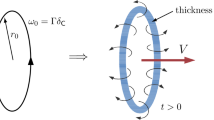Abstract
According to the Liutex-shear decomposition, vorticity can be decomposed into a rotational part, i.e., the Liutex vector, and a residual shear part. With this decomposition, the vorticity transport equation can be used to formulate a governing equation for Liutex easily for two-dimensional incompressible flows with a source term depending on the residual shear. The dynamics of Liutex-identified structures is then studied in a Taylor-Green vortex flow and a flow past a cylinder at Reynolds number of 200. It is revealed that such boundaries exist outside which the shear has trivial impact on the evolution of Liutex and inside which enhancing and weakening effects of shear on Liutex can be observed. In addition, there is a strong dissipation effect upon Liutex on these boundaries. Based on the interaction mechanism between Liutex and shear, we argue that the vortex boundaries can be identified by these highly dissipative boundaries. In contrast, traditional methods use iso-surfaces of arbitrarily selected thresholds to represent vortex boundaries. The current method of identifying vortex boundaries based on the Liutex-shear interaction has a clearer theoretical base and avoids the arbitrary selection of thresholds. Extensions to three-dimensional incompressible flows can be made in future following the same procedure but with a slightly more complex vorticity transport equation which includes the velocity gradient induced stretching or tilting term.
Similar content being viewed by others
References
Zhou S., Lu Y., Hou A. et al. Unsteady cooperative flow in compression system [J]. Propulsion and Power Research, 2012, 1(1): 12–28.
Hunt J., Wray A., Moin P. Eddies, streams, and convergence zones in turbulent flows [R]. Proceedings of the Summer Program. Center for Turbulence Research Report CTR-S88, 1988, 193–208.
Chong M. S., Perry A. E. A general classification of three-dimensional flow fields [J]. Physics of Fluids A, 1990, 2(5): 765–777.
Zhou J., Adrian R., Balachandar S. et al. Mechanisms for generating coherent packets of hairpin vortices in channel flow [J]. Journal of Fluid Mechanics, 1999, 387: 353–396.
Jeong J., Hussain F. On the identification of a vortex [J]. Journal of Fluid Mechanics, 1995, 285: 69–94.
Liu C., Gao Y., Tian S. et al. Rortex-A new vortex vector definition and vorticity tensor and vector decompositions [J]. Physics of Fluids, 2018, 30(3): 035103.
Wang Y. Q., Gui N. A review of the third-generation vortex identification method and its applications [J]. Chinese Journal of Hydrodynamics, 2019, 34(4): 413–429.
Gao Y., Liu C. Rortex and comparison with eigenvalue-based vortex identification criteria [J]. Physics of Fluids, 2018, 30(8): 085107.
Pang B., Ding Y., Wang Y. Flow behavior analysis in boundary layer transition based on the Liutex-Shear decomposition [J]. AIP Advances, 2023, 13(2): 025244.
Liu C., Wang Y., Yang Y. et al. New omega vortex identification method [J]. Science China Physics, Mechanics and Astronomy, 2016, 59(8): 684711.
Liu C., Yu Y., Gao Y. S. Liutex based new fluid kinematics [J]. Journal of Hydrodynamics, 2022, 34(3): 355–371.
Ding Y., Pang B. Y., Yan B. W. et al. A Liutex-based subgrid stress model for large-eddy simulation [J]. Journal of Hydrodynamics, 2022, 34(6): 1145–1150.
Kolář V., Šístek J. Stretching response of Rortex and other vortex-identification schemes [J]. AIP Advances, 2019, 9: 105025.
Liu C., Gao Y. S., Dong X. R. et al. Third generation of vortex identification methods: Omega and Liutex/Rortex based systems [J]. Journal of Hydrodynamics, 2019, 31(2): 205–223.
Wang Y. Q., Gao Y. S., Liu J. M. et al. Explicit formula for the Liutex vector and physical meaning of vorticity based on the Liutex-Shear decomposition [J]. Journal of Hydrodynamics, 2019, 31(3): 464–474.
Liu C., Yu Y. Mathematical foundation of Liutex theory [J]. Journal of Hydrodynamics, 2022, 34(6): 981–993.
Timm K., Halim K., Alexandr K. et al. The lattice Boltzmann method principles and practice [M]. Cham, Switzerland: Springer International Publishing, 2017.
Qian Y. H., D’Humières D., Lallemand P. Lattice BGK models for Navier-Stokes equation [J]. Europhysics Letters, 1992, 17(6): 479–484.
Wang F. Simulation of fluid flow and acoustic based on MRT-LBM [D]. Master Thesis, Wuhan, China: Huazhong University of Science and Technology, 2017 (in Chinese).
Acknowledgements
This work was supported by the Jiangsu Shuangchuang Project (Grant No. JSSCTD202209), the National Science Foundation of the Jiangsu Higher Education Institutions of China (Grant No. 22KJB130011) and the Supercomputing Center in Yancheng (Grant No. FW(W)20221001).
Author information
Authors and Affiliations
Corresponding author
Ethics declarations
Conflict of interest: The authors declare that they have no conflict of interest. Yi-qian Wang, Chaoqun Liu are editorial board members for the Journal of Hydrodynamics and was not involved in the editorial review, or the decision to publish this article. All authors declare that there are no other competing interests.
Ethical approval: This article does not contain any studies with human participants or animals performed by any of the authors.
Informed consent: Informed consent was obtained from all individual participants included in the study.
Additional information
Biography: Bi-yu Pang (1999-), Female, Master Candidate
Rights and permissions
About this article
Cite this article
Pang, By., Yu, Zd., Yan, BW. et al. Identification of vortex boundaries in two-dimensional incompressible flows based on the Liutex-shear interaction. J Hydrodyn 35, 825–831 (2023). https://doi.org/10.1007/s42241-023-0061-8
Received:
Revised:
Accepted:
Published:
Issue Date:
DOI: https://doi.org/10.1007/s42241-023-0061-8



